Being Spider-Man never gets old. The rush of swinging like a pendulum through Times Square, the thrill of pirouetting through a high-stakes crime bust, the satisfaction of watching a chorus of tiny Spidey gizmos wrap up another band of bad guys with elegant ease—even after completing everything there is to do in Marvel’s Spider-Man 2, I still feel the tug to return and hurl myself down the streets of its New York City one more time. Its serpentine comic-book drama and explosive set pieces might not stick with me for years to come, but I will forever hear the siren call of its bustling world and the effortless grace with which it pulled me through it.
Editor’s note: You’re reading the Kotaku US review of Spider-Man 2. If you’d like to read the Kotaku Australia review, you can find it right here. — David.

With 2018’s Spider-Man, Insomniac Games nailed the moment-to-moment feeling of being New York’s favorite wall crawler. The more compact and intimate spin-off, Miles Morales, reprised the experience with even more vibrant panache in 2020. Out October 20, this year’s Spider-Man 2, the first one made exclusively for the PlayStation 5, is the formula at its most refined and maximalist, with even more stuff to do and no shortage of ways to look and feel amazing while doing it. Being Spider-Man has never felt better or looked prettier.
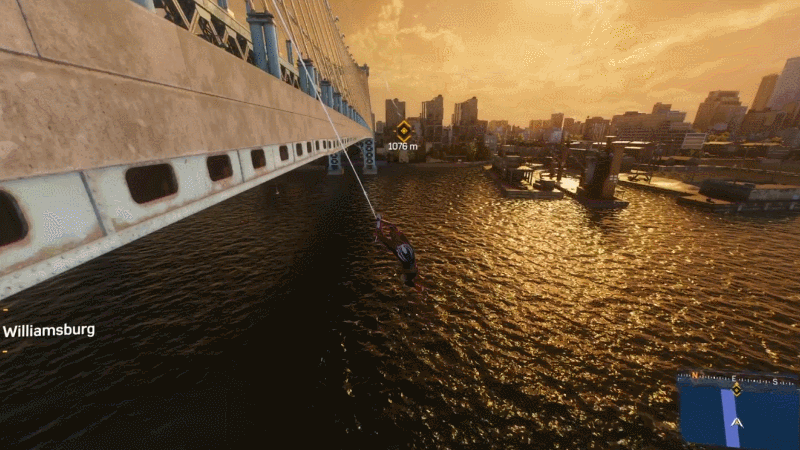
Everything that surrounds it, from the rapid-fire story beats to the uninventive interior levels, is equally prodigious if much more uneven. Following in the weighty footsteps of fellow big-budget sequels Horizon Forbidden West and God of War Ragnarök, Spider-Man 2 is bursting at the seams with more of everything, from new collectibles and mission types to extra suits and upgrades. The map is larger, the fights are bigger, and the combat is flashier. The action adventure game is a super-sized value proposition that often impresses and frequently overwhelms but rarely surprises.
Spider-Man 2 doesn’t mess too much with what already worked. It doesn’t fundamentally evolve on it either. It’s by far the best game in the series, with a story that’s unexpectedly impactful in its depiction of friendship, resentment, and loss. Though they don’t always land, the game takes some bigger thematic swings than its predecessors. At the same time, it’s still fundamentally a popcorn blockbuster; an all-time great depiction of Spider-Man on the screen that’s not quite the all-time classic game Insomniac feels capable of creating. I hope I sound conflicted, because I am. Spider-Man 2 is an exhilarating and exhausting rollercoaster ride that I mostly loved, outside of some small disappointments and a handful of minor annoyances.
Peter Parker can barely keep his life together in-between emergency alerts on his friendly neighborhood spider app and supervillains rampaging through downtown. He’s still with Mary Jane, but he’s struggling to hold down a high school teaching gig and he’s months behind on the mortgage. That poor work-life balance has rubbed off on Miles Morales too. The teen superhero still hasn’t found time to finish his college application essay, let alone confront the guilt and anger left over from his father’s death at the hands of billionaire philanthropist turned crime lord Martin Li, aka Mister Negative.
The chaos is amplified when Harry Osborn, revealed in the first game to be living in a green water tank in his father’s hidden lab, re-enters Peter’s life out of the blue, his debilitating Oshtoran Syndrome seemingly cured. Kraven the Hunter, meanwhile, has infiltrated New York’s underground in an attempt to capture its most deadly supervillains in the hopes that one of them will prove a worthy opponent for his endless sadism and bloodlust. It’s no wonder Peter hasn’t found time to finish unpacking from his move back home. I haven’t even mentioned the remnants of Sandman stalking entire city blocks or the cult of arsonists blowing up tanker trucks at major intersections. Throw Venom into the mix and it sounds like way too much. Occasionally it is. Spider-Man has never been busier.
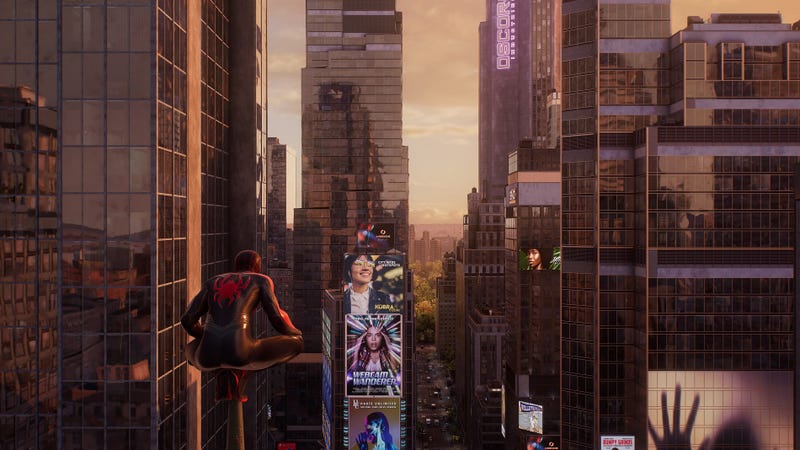
Instead of following the exploits of just one hero, Spider-Man 2 makes both Peter and Miles playable, switching back and forth as missions and plot developments necessitate, or on the fly if you’re out in the world. Each has a unique wardrobe, dedicated skill trees, and new sets of abilities, with gadgets and some upgrades shared across both. The systems are more varied as a result, but also more shallow. Skill points are divided between the heroes, and if you don’t invest them in the shared tree, it can feel like you’re shortchanging one or the other. Suit powers have also been replaced by just two ultimate abilities for both Peter and Miles. It all has the effect of making the full arsenal of abilities feel smaller since they’re divided between the two, which in turn made it harder for me to identify as closely with either individual hero and feel like we were one and the same, growing stronger, more practiced, and more emotionally mature as the game unfolded.
The paths each Spider-Man takes throughout the story often overlap and crisscross, but they also have their own relationships to navigate and pet projects to work on. Peter has science experiments scattered throughout New York that need his expertise. Miles’ uncle, Aaron Davis, aka The Prowler, is out of prison and needs his nephew’s help keeping his old tech caches from being ransacked. Two main characters means twice as many cell phone contacts to get calls from, and twice as many friends and family to leave disappointed when the job of being Spider-Man has you ignoring what they need to go save the world one more time.
The quintessential Spider-Man 2 experience is this. I’m whipping past apartment buildings in Greenwich Village during the evening commute as the sun goes down. A red icon alert pops up on the minimap notifying me of a robbery nearby. I shift my weight and cut through an alley in the direction of the emergency when a podcast comes on and J. Jonah Jameson starts ranting about so-called reformed criminals. Before I can get two blocks a technicolor wave tips me off to a lost spider-bot nearby, and I course-correct again to snag the collectible. Now Mary Jane is calling me to talk about the bills that are piling up at home. But before she can get started I descend on the robbers and have to hang up. Miles is already there kicking their asses and we make short work of it. He says goodbye. MJ starts calling again. And a new side-mission prompt appears in the top right corner of the screen. The joint banking account will have to wait.
This is when Spider-Man 2 is at its best, leaving you feeling overloaded and out of breath, your attention yanked in half a dozen directions at once, just like that of its titular heroes. It’s also when the game reveals its strongest character of all: a more sprawling and revitalized recreation of New York City. Brooklyn and Queens have joined the map, with the water separating them from Manhattan free to surf across. Spider-Man can also fly now. A new wingsuit lets Peter and Miles glide for long stretches with a single button press. Air vents will shoot you up into the sky while wind tunnels propel you across vast distances, including the East River. It’s a simple addition that makes traversing the urban playground feel revelatory all over again.
In many ways, the city itself is as plastic as ever. You’re not visiting shops. The charming subway loading screens that accompanied fast travel before are gone, now so unnecessary thanks to the PS5’s SSD that you simply reappear in another part of the city just a few seconds later. It’s the most expensive virtual recreation of New York ever and you can’t even buy a cup of coffee. But various scenes and side-missions still imbue it with a sense of the day-to-day mundanities that make it feel worth protecting. There’s Miles’ high school, and the foundation Harry recruits Peter to join, with break-ins at a Harlem music museum and undercover infiltrations at country clubs offering a much more dynamic panorama of non-superhero life than the first game. Better lighting, reflections, and detailed building configurations make for a city that looks more breathtaking and lifelike than ever.
Then there are the collectibles, randomly generated emergencies, and side-missions that sprout up throughout the city. Mysterio’s virtual reality kiosks act as combat time trials. Kraven outposts have you subdue his hunters and avian drones in exchange for the locations of his secret hideouts. A new side-gig submitting photos to Robbie Robertson’s newspaper has you snapping shots of bespoke locations and moments sprinkled around town, enriching it in the process. It’s here that the game seems to have learned the most from Miles Morales’ focus on the “neighborhood” aspect of Spider-Man’s legacy.
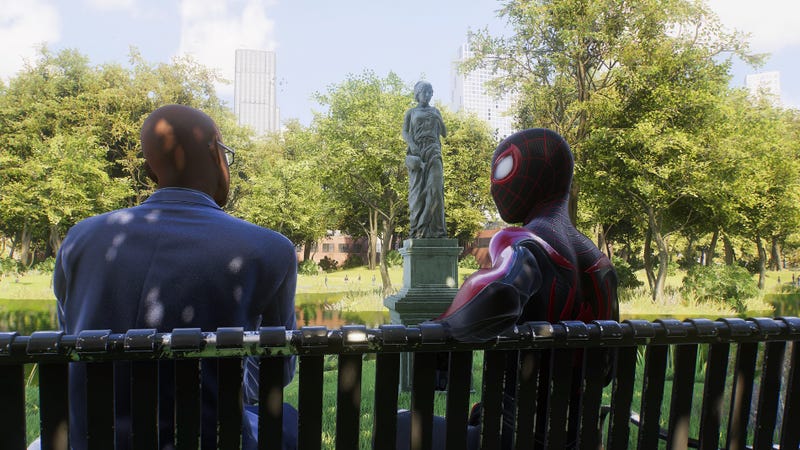
Side-missions feel more embedded in the fabric of the city. One of them had me help a woman track down her grandfather who suffered from dementia. When I finally found him sitting on a park bench near a pond, he told me about how this was where he proposed to his wife, and coming back there helped him relive the best moments of their love together all over again. He can feel himself fading but he’s still not ready to die. “I thought I’d feel ready but it doesn’t get any easier,” he says. There are no supervillains or Marvel easter eggs here, just a poignant moment of vulnerability that underlines the human stakes of a life completely dominated by Spider-Man’s responsibilities.
Not all of the color-coded icons on the map are electrifying distractions or emotionally resonant, but most play to Spider-Man 2’s strengths, forcing you into the familiar but satisfying rhythms of web slinging and acrobatic fisticuffs in-between taking in the sounds, sights, and ray-traced vibes of the city that never sleeps. The critical mass of distractions can be repetitive, yet rarely stoop to feeling tedious. I felt a deep-seated kinship with Robertson when he pointed out the water tower turned bar he used to visit to gripe about work. Big same, man.
If web-slinging is Spider-Man 2’s primary verb, beating the shit out of people is the second one. The first Spider-Man borrowed from the Batman: Arkham games, forgoing complex, freeform combat in favor of a visually rich but simplistic combo system. Whale on enemies until they’re out cold or dodge when a red prompt appears to get out of the way of an incoming attack. Spider-Man 2 has gone one step further by introducing parries, a new wrinkle that adds another layer of complexity to battles.
Special powers are another part of the tool box. In addition to spider gadgets that web, shock, or concuss, there are spider abilities that completely wreck rank-and-file goons. Peter’s set relies on mechanical spider-legs to ram, smash, stun, and toss enemies, while Miles’ Venom punches shock and electrify. If you thought the Emperor’s force lightning from Star Wars was what the last games were missing, don’t worry, Miles has it now. Peter also has an additional group of powers when he eventually dons the Venom suit, unleashing the symbiote’s power to thrash and fling enemies with his oily tendrils.
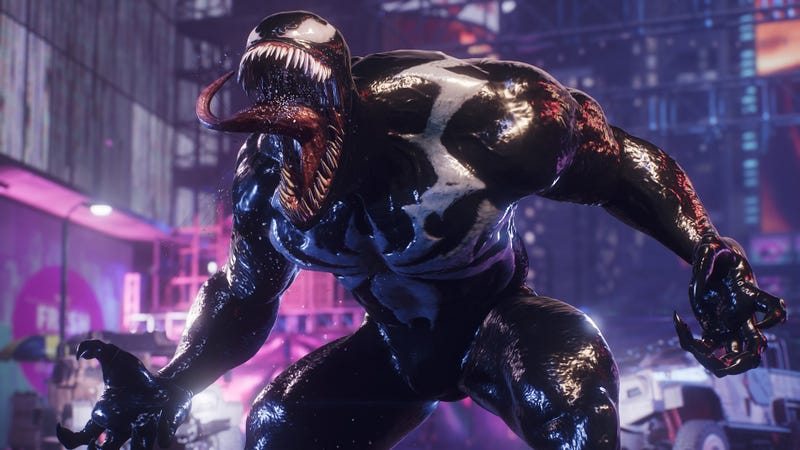
Each is a blast to use, even if I missed the larger arsenal of gadgets from the first game. But the battles themselves often devolve into a brawlfest as a result. Where Spider-Man and Miles Morales felt more precise and calibrated in their enemy encounters, Spider-Man 2 can feel like wave after wave of just pummelling whoever’s closest until everyone is unconscious. I was still paying attention to snipers I needed to dodge or attacks from behind I could parry, but there wasn’t the same satisfaction of cleverly jumping from one enemy to the next to build up a combo to eventually activate a sequence of cinematic takedowns. The game seemed to compensate for my new powers by throwing small armies at me, leading to some encounters feeling drawn out and overstaying their welcome by the end.
That’s less of an issue in Spider-Man 2’s boss fights, which are generally tense and exciting, even if they too devolve into simple slugfests more often than not. On the one hand, I enjoyed using the combat skills I’d mastered in regular fights to take down super-powered foes. On the other hand, it made showdowns with the Lizard, Kraven, and even Venom feel more predictable than they otherwise might have been. If I have one real complaint about the boss fights, though, it’s their endless use of mid-battle cutscenes that, when over, find that boss you just “defeated” back at full health and ready for another round. Each major fight is so consistently choreographed in that regard that it begins to feel like going through the motions.
The same can be said of many of its interior environments. When receding from the city proper to search for clues in a mysterious facility or infiltrate an enemy hideout, Spider-Man 2 tends to get boring. Mary Jane’s dreaded stealth sequences return from the first game, only this time she has better weapons and the reflexes of a Shield operative. A few levels let me pursue a more meticulous plan of attack, incapacitating an enemy here or there from the shadows before throwing down with the rest. But mostly the game was content to let me wallop through encounters, break to quietly rummage around desks for important clues, and then web my way through corridors at breakneck speed to escape. These inoffensive, unremarkable sequences typically just serve to provide a breather from the explosive and action-packed setpieces punctuating every other scene. It’s more Naughty Dog’s Uncharted than Insomniac’s previous Sunset Overdrive.
I did not expect myself to become so invested in Spider-Man 2’s emotional stakes. This is, after all, a game where you spend a hell of a lot of time collecting various tokens in order to unlock costumes like someone trapped inside a Spirit Halloween arcade. But amidst the convoluted reimaginings of long-standing comic book arcs, Spider-Man 2 hits sparingly but impactfully in some key moments, thanks in part to all of the groundwork laid in the first two games. You don’t have to have played the 2018 or 2020 games to enjoy Spider-Man 2, but those who did will find the biggest payoffs.
Peter hasn’t exactly grown up, but the world around him has. That’s kind of the problem. He thinks he can still pour everything he has into being a full-time superhero without those closest to him beginning to resent him for it. His Uncle Ben died because he failed to live up to the responsibility of his powers. But the rest of his life is crumbling because he can’t figure out when he owes it to those he loves to put that aside. One thing Spider-Man 2 bravely posits is that Peter might not always be busy web-slinging simply because it’s his superhero duty, but because he’s afraid of doing all the things his powers don’t make him innately better at, like life.
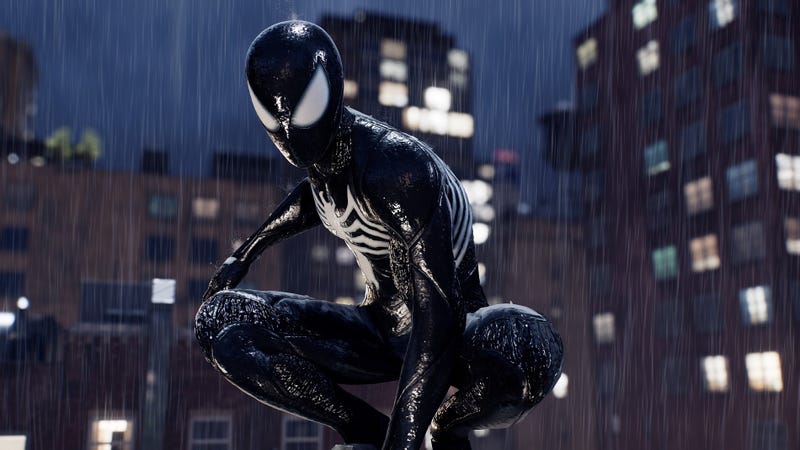
When Peter first acquires the Venom suit it makes him more powerful, replacing his robotic arm attacks with giant black tendrils that bulge and squirm as they thrash enemies up in the air, sling them against walls, or simply pummel them into oblivion. As Spider-Man 2 throws bigger and bigger mobs of Kraven’s Hunters and other minions at you, it becomes a relief to be able to quickly silence them with the ease and simplicity of an old-school arcade brawler. The suit exposes the weaknesses in Peter’s life though, deepening the rifts between him and those closest to him. We all have frustrations, jealousies, and insecurities buried deep inside us, carefully kept hidden until the mess of life begins to unearth them again. Venom is Spider-Man 2’s way of finally forcing its characters to say the things better left unsaid.
Early on, Harry surprises Peter with a bike ride that quickly turns into breaking and entering at their old school. The tour, which doubles as a stealth tutorial, cuts to flashbacks of their childhood antics. At the end, it shows the two escaping onto the football field back in the past, only for Harry’s billionaire father to land in a helicopter and whisk him away. His mother had just died. The ensuing silence as Harry and his dad take-off underlines the distance between the two of them, one which they rarely find the time to acknowledge but which eventually leads to cracks in their relationship.
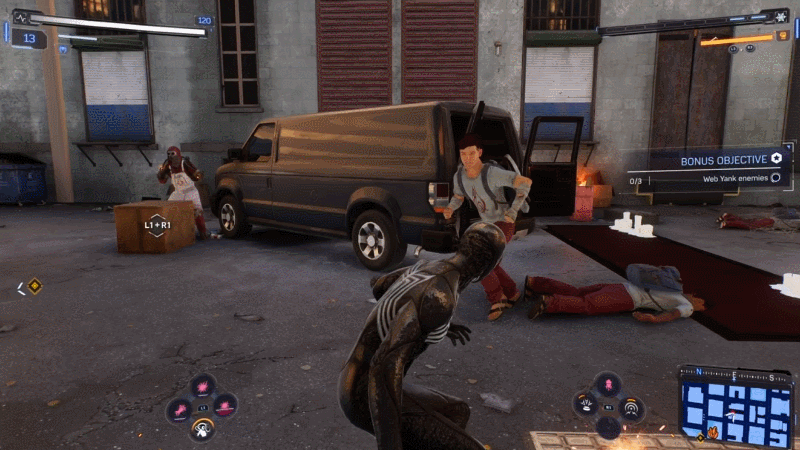
It’s a small moment. A quiet one. Even when the game descended into a full-on Marvel’s Avengers slugfest in the final third, my mind kept coming back to this scene and what it said, without saying anything at all, about the traumas we carry with us, and the ways we avoid discussing them with one another, either because we’re afraid or we’re just too conveniently busy. Much later in Spider-Man 2, Miles is trying to rescue Peter, only to be absently reminded of Aunt May’s death. He chides himself for never having found the time to do the most obvious thing of all: talk to Peter about it.
While the writing is generally excellent, it doesn’t always make up for the lack of imagination that periodically throttles entire extended sequences. In another one of Spider-Man 2’s breaks from the fighting, Peter, Harry, and MJ relive their old adventures at Coney Island. There are a bunch of games to play and rides to go on. Completing each lets you pick out a prize. Harry keeps talking about how it’s the best night he’s had in a long time. Compared to some of the mini-games in a game like Final Fantasy VII Remake, though, it feels a bit like coming to life in a wax museum. A button prompt lets you throw your arms up and shout during rides, but it’s stiff and unresponsive, leading to absurd sequences where a heart-to-heart is interrupted by a “Wahoo!” It’s just another moment in which Spider-Man 2 feels like it’s going through the motions when it could be doing so much more.
Spider-Man 2, like its predecessors, remains a hopelessly binary game. There’s the part where you’re flipping through the city on a scavenger hunt for brightly colored icons to wipe off the map in exchange for power-up currencies and the satisfaction of ticking one more task off the superhero’s to-do list. It’s simultaneously very game-y and incredibly special, loaded up with enough new variables to make it feel even more dazzling than before.
Then there’s the very on-rails critical path that catapults you from one crisis to another, telling a movie-like story in carefully choreographed scenes with top-notch performances. Spider-Man is still free to whip around mini-arenas taking out foes and locating a handful of clues but it’s mostly an elaborate ruse, complete with new quick-time events that take advantage of the DualSense haptics and Adaptic Triggers, to convince you that you are actively doing something cool rather than just watching cool stuff happen. That’s mostly fine. I like watching cool stuff happen!
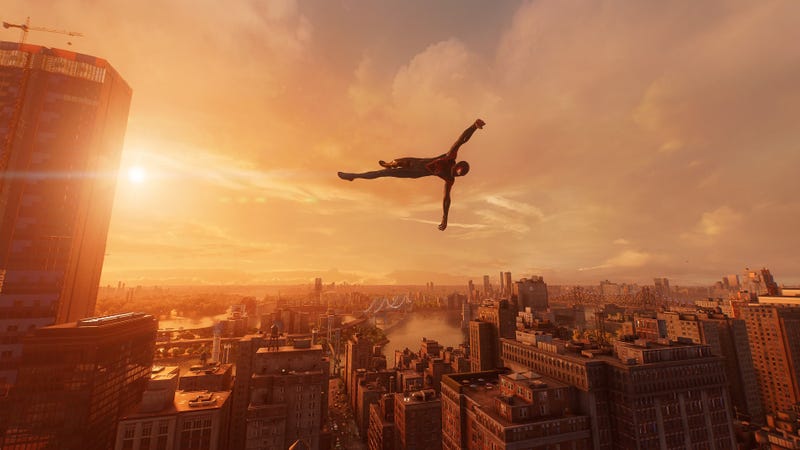
But it does usually have me letting out a long sigh of relief whenever I finally get back to the street, where I’m free to partake in what Spider-Man 2 continues to do best. I wish I could say that all of the more, more, more that’s heaped on here coalesced into a fundamentally different game than Spider-Man or Miles Morales. It’s definitely a better one, if not yet the perfect one. Insomniac’s take on pivotal Spidey moments like Peter confronting Venom are entertaining and extravagant. They are also much less interesting than the game’s more intimate collisions between young comic book superheroes and the rich urban world around them. There’s just too much that still feels ancillary to what makes the games so great; an endless march of button prompts intended to convince you that you are playing a movie rather than watching a game.
All of the new features and wrinkles, from the addition of Miles to a whole second set of Venom powers, kept me busy. This frenetic collage makes for a more lively adventure overall, but at the expense of never quite giving any one character or scene quite long enough to breathe and tell you everything it feels like they want to say. If it were a television show, it would feel both too long and yet also a few episodes short of a full season. Maybe that’s what the DLC will be for. Or the inevitable next sequel in the franchise. “It makes me a better Spider-Man,” Peter says at one point as he begins to fall prey to the seductive power of the symbiote. It felt like a worthwhile warning for the game as well, which occasionally seems so caught up in providing an even meatier followup that it loses some focus on what actually makes these games so great.
Whatever lack of satisfaction I walked away from Spider-Man 2 with ultimately paled in comparison to the joy of flying over its cityscapes and being able to pretend, however briefly, that I was a member of its bright metropolis where every challenge can eventually be overcome, at least with the help of a suit, super powers, and a perfectly timed *thwip*. The game surrounding it could be much worse and I’d still come running back each time. Fortunately, it is as good as it’s ever been, and in plenty of ways, even better. Being Spider-Man never gets old.
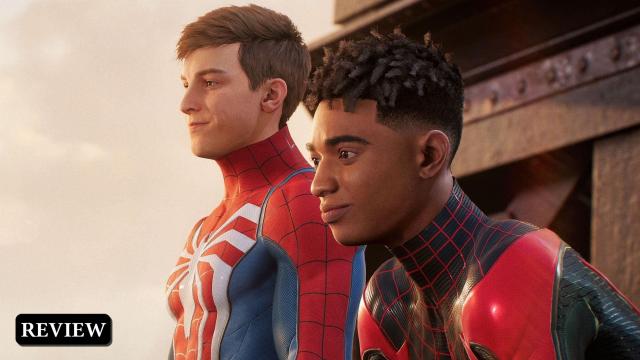
Leave a Reply